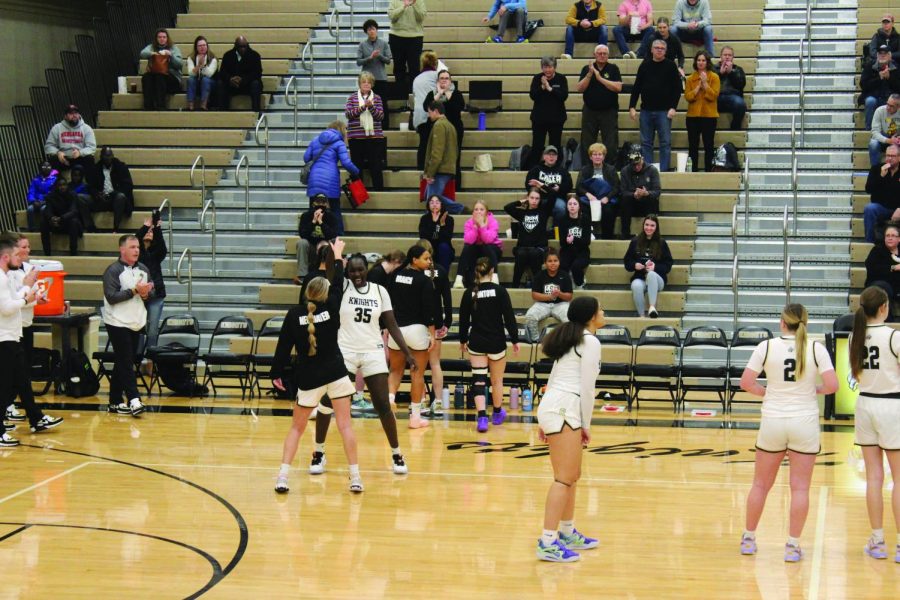Gender disparities shown in unequal attendance of boys and girls sports
Sophomore Ava Neumayer supports Junior Nyaluak Dak as LSE athletes names are announced at girls varsity basketball game against Lincoln East.
March 20, 2023
At the beginning of a home Varsity Girls Basketball game, you can expect two or three rows of students in the student section and close family of the athletes in attendance. As the game goes on, the gym will slowly start to fill, but the gathering crowd isn’t there to cheer on the team on the court. They are there to claim seats for the boys game taking place next.
At a Varsity Boys Basketball home game, there is typically a large crowd full of students and parents with the LSE student section being at least half way full. Unfortunately the same cannot be said for girls basketball. This has become the social norm at LSE and other Lincoln schools, and also in other sports. The attention given to boys’ sports is not equally reciprocated to girls. This attitude and outlook has an effect on our female athletes.
“It makes me pretty upset that the boys get more respect,” Equity Cadre member and varsity basketball player, Nyaluak Dak said. “We had the same record, we’re doing pretty good this year and Southeast basketball has been getting better, but that’s just a respect thing. Especially when our head Designated Fan Association (DFA) people don’t show up for a game”.
Dak says the lack of attendance affects the team’s morale and can even affect their performance.
LSE DFA did not respond when asked for comment on their attendance. When it comes to the DFA, the athletes notice the lack of support from the student led organization. Dak hopes that with help from the DFA attendance could be boosted and games could be more heavily promoted. As of right now, she believes the support from the student body and the DFA is not felt by girl athletes.
“I think we’ve learned to not really expect anything from the student section, because even when they do come in, they don’t cheer us on like how they would the boys team,” varsity soccer and basketball player Mirabelle Hesse said. “You’ve just had to learn how to play through that.”
The girls’ teams are not the only ones who notice the difference in crowds.
“I think that a lot of people like watching the boys’ games more which is very unfair to the girls because there’s just as good of a product being put out there,” Varsity Basketball player Daniel Schaefer said.
Regardless, Schaefer has been given reasons for the lack of attendance.
“The issue comes down to preference, publicity, and timing. Often audiences prefer to watch the boys game because they find it more interesting,” Schaefer said. “Boys sports unfortunately do get much more publicity than girls and when it comes to the times of games, varsity girls games are often put in an awkward spot for a lot of people. This awkward spot in the day, usually around 5:45 p.m., makes it hard for people who would like to support girls’ basketball to be able to make it.”
Band member and varsity track and cross country runner Nathan Johnson believes crowds may be more likely to attend a girls’ game if the game times for girls’ and boys’ were switched.
“If you’re trying to get more people to go to a women’s game you could put it second because right now it’s first and, in general, it’s probably easier to go to a later game than an earlier game,” Johnson said.
Not only is it important to address this for gender eqaulity reasons, but lack of crowd support can also affect player performance.
When it comes to coaching, LSE Athletic Director Kara Graham said “I had some players that played much better in front of a big crowd. However, I had other athletes that got very nervous in front of a big crowd and we played better on the road in front of less people.”
The issue of girls and boys sports attendance cannot be solved in a day but can be helped with a bit of support from LSE’s staff and students in prioritizing all sports, no matter the gender.









